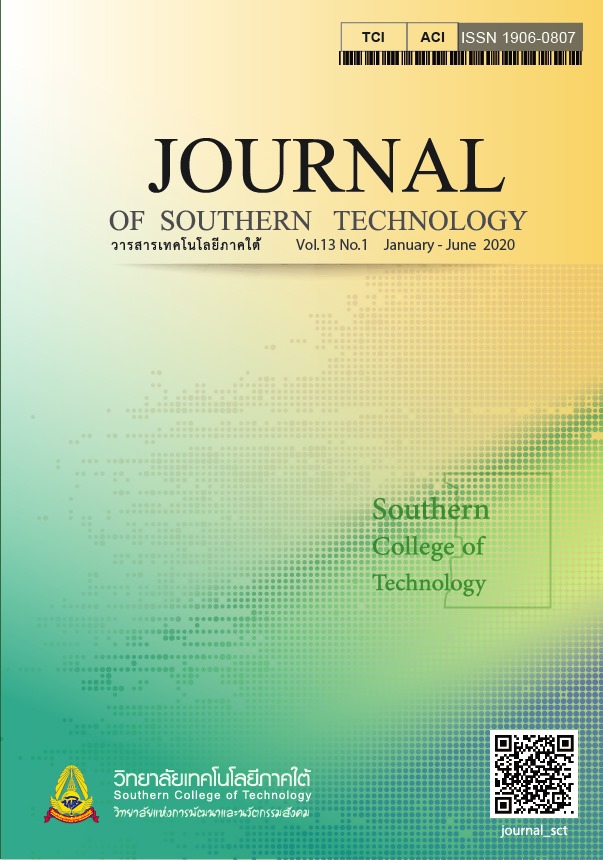Innovative Community-Based Living Weirs for Sustainable Solutions to Drought in Khaopu Sub-district, Si Banphot District, Phatthalung Province
Main Article Content
Abstract
This research aimed 1) to create a water restoration model, 2) to investigate water management learning process, and 3) to create water management mechanism in Khao Pu sub-district, Si Banphot district, Phatthalung province which causes water scarcity in agriculture and for general consumption, lack of food sources, and disappearance of water-reliant community way of life. The community, related sectors, and the researcher have studied these issues to find common solutions on how to apply innovative living weirs to the foothill areas which are affected by widespread flooding during the rainy season. Living weirs can slow down the flow of flood waters, help with water retention, increase soil moisture, waterfront plants and native fish, serve as a recreational place, become an income source for the riverfront community, serve as a community learning center for sustainable drought solutions. This qualitative research collected data through document analysis, in-depth interviewing, focus group discussion, participatory and non-participatory observations. The key informants, selected using a purposive sampling method, included community inhabitants, community network organization group, and government stakeholders involved in utilizing living weirs for drought problem solving in Khao Pu sub-district, Si Banphot district, Phatthalung province. Analytic induction was employed for qualitative data analysis.
The research findings revealed that (1) the community and the researcher were able to create a water restoration model for sustainable drought solutions including 1.1) cultivating community consciousness of water preciousness, 1.2) innovative living weirs, 1.3) providing the community a better understanding through water management learning process, (2) the community inhabitants have developed their learning process through 2.1) community participation in creating innovative living weirs, 2.2) common practice of community collaboration networks, 2.3) community performance evaluation, and 2.4) collaborative problem solving, and (3) water management mechanism has been used to strengthen community self-management. As a result of this type of knowledge network, they have constructed 6 innovative living weirs namely 1) Huai Yuan Weir in Moo 7 and 11 areas, 2) Huai Klay Weir in Moo 1 and 8 areas, 3) Huai Pleah Weir in Moo 4 area, 4) Huai Chunhawan Weir in Moo 4 area, 5) Klong Khao Kaeo Weir in Moo 4 and 8 areas, and 6) Huai Rod Weir in Moo 9 area.
Article Details
-
Authors must agree to the journal publication rules and allow the editors to edit the manuscripts for publication.
-
Author’s right belongs to the author but Journal of Southern Technology holds the right of first publication and thus allow readers to use the article for the purpose of education but not commercial.
References
Boonleiy, S. (2017). Development process of water management for sustainable agriculture: a case study of Tha Ka-serm Tam-Bol, Num-Pong, Khon Kaen Province. Khon Kaen, Thailand: Graduate School, Silpakorn University. Veridian E-Journal, 10(2), 1771-1784. [in Thai]
Chantawanit, S. (2000). Qualitative Research Method. Bangkok: Chulalongkorn University Publisher. [in Thai]
Mankhoksoong, P. (2015). Wetland Management in SongKhram River Basin the Upper North Eastern of Thailand (Research Report). Khon Kaen, Thailand: Khon Kaen University. [in Thai]
Ngamwittaroj, B., Adirektrakran, W., & Noppkunkajon, C. (2009). Water Management, Mix Method Water Resource Management Research (Research Report). Bangkok: Department of Water Resource. [in Thai]
Sonmuangbun, A., & Prakongsri, P. (2010). Water Management for Agricultural Propose within Irrigation Area for an Effectiveness of a Sub-district Administration Organization: A Case Study of Tha-Pha Sub-district Mueang Khon Khan Province (Research Report). Bangkok: Department of Water Resource. [in Thai]
Yotarak, D., Rattanakot, N., Sudsomboon, S., Phimprapan, A., Yusakun, O., Chotcharat , P., Amloy, P., & Piyapisuthisak, P. (2018). Water resource management by living weir: a case study of Yangkom Living Weir-Pipoon District, Nakhon Si Thammarat Province. Journal of Southern Technology, 12(1), 158-166. [in Thai]

